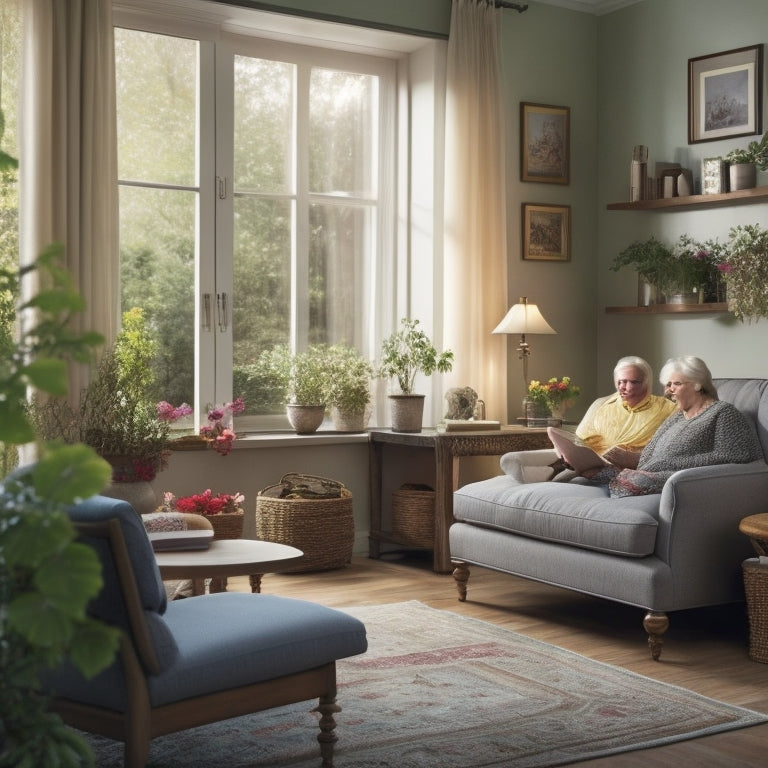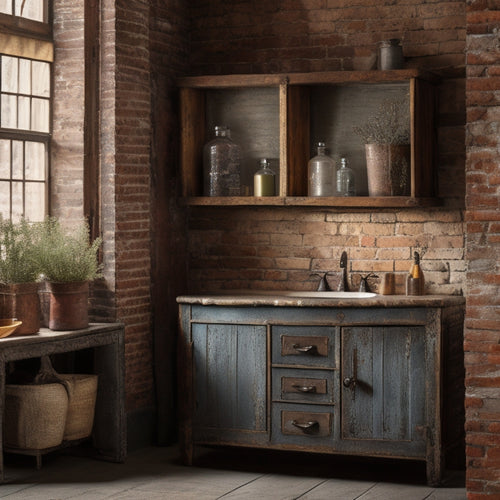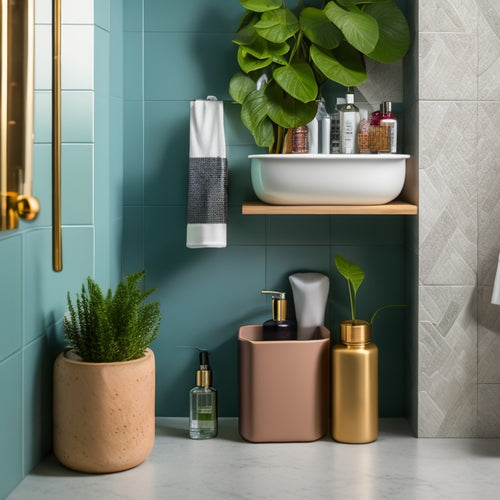
Senior-Friendly Design Ideas for Easy Accessibility
Share
You're designing a space that's safe, comfortable, and easy to navigate for seniors, and that means considering every detail. Start with the bathroom, where clear pathways, grab bars, and easy-to-view mirrors make a big difference. Next, choose senior-friendly flooring like cork or luxury vinyl tiles that provide comfort and traction. Don't forget easy-to-use shower systems with intuitive controls and comfortable seating. Then, select comfortable seating solutions with adjustable heights and depths, and prioritize safety in storage solutions. As you explore these ideas, you'll discover even more ways to create a space that's both beautiful and accessible.
Key Takeaways
• Clear pathways and furniture placement are crucial to ensure easy accessibility and reduce tripping hazards in senior-friendly designs.
• Incorporating intuitive shower systems with comfortable seating, grab bars, and personalized water pressure can enhance safety and comfort.
• Senior-friendly flooring options like cork, luxury vinyl tiles, and rubber flooring provide underfoot comfort, slip-resistance, and excellent grip.
• Ample lighting strategies, including task lighting, natural light maximization, and nighttime navigation aids, can reduce eye strain and enhance functionality.
• Considerate storage solutions with secure shelves, hidden compartments, and grab bars can promote independence, accessibility, and safety.
Accessible Bathroom Layout Essentials
To create a bathroom that's safe and easy to navigate, start by arranging the layout to provide a clear path for movement, ensuring that all essential fixtures and features are within comfortable reach. This means considering the 'traffic lane' in your bathroom, making sure there's enough space to move around the room without feeling cramped or claustrophobic.
Next, think about the placement of grab bars, strategically installing them near the shower, toilet, and bathtub to provide support and balance. For example, you might place a grab bar near the showerhead to help with getting in and out of the shower.
Additionally, consider the positioning of bathroom mirrors, placing them at a height that's easy to view from a seated position, reducing strain on your neck and back.
Senior-Friendly Flooring Options
As you finalize your bathroom layout, ponder over the flooring that will provide the foundation for safe and easy movement, and start exploring senior-friendly options that can greatly reduce the risk of slips, trips, and falls.
When it comes to senior-friendly flooring, there are several options to contemplate. Here are a few that stand out:
-
Cork flooring: Offers underfoot comfort, acoustic benefits, and is soft on joints.
-
Luxury Vinyl Tiles (LVT): Provides a slip-resistant surface, easy to clean, and mimics natural stone or wood.
-
Rubber flooring: Provides excellent grip, reduces noise, and is comfortable underfoot.
- Non-slip ceramic tiles: Features textured surfaces, slip-resistant coatings, and is easy to clean.
These flooring options not only provide a safe and accessible environment but also offer aesthetic appeal, making your bathroom a comfortable and enjoyable space.
Easy-to-Use Shower Systems
Step into a shower system that's tailored to your needs, where intuitive controls, comfortable seating, and personalized water pressure converge to create an invigorating and rejuvenating experience.
As you design your ideal shower system, consider the importance of easy-to-use features that cater to your needs. Start with showerhead options that provide a range of spray patterns and water pressures, allowing you to customize your shower experience.
For added convenience, incorporate grab bars in strategic locations, such as near the showerhead or on the wall, to provide support and balance. This thoughtful placement guarantees you can move safely and confidently throughout the shower.
Comfortable Seating Solutions
As you design your comfortable seating solutions, you'll want to take into account a few key factors to guarantee your chairs are both functional and relaxing.
You'll need to think about the ideal chair height and depth for easy transfer and comfort, as well as the type of cushioning and support that will keep users comfortable for extended periods.
Chair Height and Depth
You can create comfortable seating solutions by selecting chairs with adjustable heights and depths that accommodate a range of body types and abilities. This is especially important for seniors, who may have mobility or flexibility issues that make it difficult to get in and out of chairs. By choosing chairs with adjustable heights, you can guarantee that the seat is at a comfortable height for each user, reducing strain on their legs and back.
When it comes to chair depth, consider the following factors:
-
Seat comfort: A deeper seat can provide more comfort and support, but may be harder to get in and out of.
-
Back support: A chair with a deeper seat often provides more back support, which is essential for seniors who may have back problems.
-
Leg room: Make sure there's enough leg room to allow users to sit comfortably with their feet flat on the floor or on a footrest.
- Arm height: Adjustable arm height can help users get in and out of the chair more easily.
Cushioning and Support
To guarantee comfortable seating solutions, consider the type and density of cushioning, as well as the level of support provided by the chair's ergonomic design, which can greatly impact the user's overall comfort and ability to sit for extended periods.
When selecting a chair, look for features that prioritize pressure relief and body alignment. You'll want to choose a chair with cushioning that provides adequate support for your body, particularly in areas prone to pressure points, such as the hips and buttocks. A well-designed chair will cradle your body, promoting good posture and reducing discomfort.
Here are some key considerations for comfortable seating:
| Feature | Benefits |
|---|---|
| High-density foam cushioning | Provides excellent pressure relief and support |
| Contoured seat and backrest | Promotes body alignment and reduces strain |
| Adjustable lumbar support | Allows for customized support and comfort |
Ergonomic Armrests
With ergonomic armrests, your chair becomes an extension of your body, providing excellent comfort and support that lets you focus on the task at hand. As you sit, you'll appreciate the customizable curves that cradle your arms, reducing strain and fatigue.
The adjustable height feature guarantees a perfect fit, whether you're working, reading, or simply relaxing.
Here are four key benefits of ergonomic armrests:
-
Reduced strain: By providing ideal support, ergonomic armrests reduce strain on your neck, shoulders, and back.
-
Improved posture: Customizable curves encourage good posture, which can help alleviate back and joint pain.
-
Increased productivity: With comfortable, supported arms, you'll be more focused and productive.
- Enhanced relaxation: Ergonomic armrests promote relaxation, making it easier to unwind and recharge.
Safety-First Storage Ideas
Prioritizing safety-first storage ideas in your daily routine can greatly decrease the risk of accidents and injuries in the home.
As you age, focusing on storage solutions that promote independence and reduce the risk of falls or strains is crucial. You can start by installing secure shelves that are sturdy and easy to access. Consider shelves with built-in handrails or grab bars for added support.
Hidden compartments can also be a game-changer, allowing you to store valuable or sensitive items out of sight. For example, you can install a hidden compartment in your dresser or nightstand to store medications, jewelry, or important documents.
Clear Floor Pathways Matter
Clear floor pathways become your lifeline, providing a safe and obstacle-free route through your home as you navigate daily activities. As you age, tripping hazards and clutter can become a serious safety concern, leading to falls and injuries. That's why maintaining clear floor pathways is essential for easy accessibility.
To achieve this, focus on clutter control and strategic furniture arrangement. Here are some practical tips to get you started:
-
Remove tripping hazards: Keep floors clear of cords, wires, and rugs that can cause tripping.
-
Optimize furniture placement: Position furniture to create a clear path through each room, avoiding narrow walkways and tight corners.
-
Store items out of the way: Keep clutter at bay by storing items in designated areas, such as closets, shelves, or cabinets.
- Use multi-functional furniture: Choose furniture pieces that serve multiple purposes, reducing clutter and freeing up floor space.
Simple Faucet Handles Design
You can easily upgrade your sink's usability with simple faucet handles that don't require a tight grip or excessive twisting. This is especially important for seniors who may have arthritis or other mobility issues that make it difficult to operate traditional faucets. Simple faucet handles with lever operation provide grip comfort, allowing users to easily turn the water on and off with minimal effort.
| Faucet Handle Type | Description |
|---|---|
| Lever Handle | Easy to operate with a gentle push or pull |
| Single-Handle Faucet | Combines hot and cold water into one handle |
| Touchless Faucet | Activated by hand or arm movement, no handle needed |
| Cross-Handle Faucet | Two separate handles for hot and cold water |
When selecting a faucet handle, consider the user's grip strength and dexterity. A faucet with a comfortable grip and easy lever operation can make a significant difference in the user's ability to independently perform daily tasks. By choosing a faucet handle that prioritizes grip comfort, you can create a more accessible and senior-friendly kitchen or bathroom.
Non-Slip Flooring Materials
As you focus on creating a senior-friendly space, consider the flooring, where a single slip can have devastating consequences, and opt for non-slip flooring materials that provide a secure surface underfoot. This is especially important in areas like bathrooms and kitchens, where water and soap can create hazardous conditions.
When selecting flooring, look for materials with built-in slip resistance or apply slip-resistant coatings to existing floors.
Some popular options include:
-
Rubber flooring: Soft and flexible, rubber flooring provides excellent grip and cushioning in case of falls.
-
Textured vinyl: With its embossed patterns, textured vinyl flooring offers improved traction and is easy to clean.
-
Ceramic tiles with non-slip glaze: These tiles feature a specialized coating that increases friction, reducing the risk of slips.
- Natural stone with slip-resistant sealant: Apply a slip-resistant sealant to natural stone flooring to enhance its safety features.
Ample Lighting Strategies
As you design your space for easy accessibility, you'll want to contemplate ample lighting strategies that cater to diverse needs.
You'll focus on three key areas:
task lighting essentials that facilitate daily activities,
natural light maximization to boost mood and visibility, and
nighttime navigation aids that guarantee safe movement.
Task Lighting Essentials
Task lighting is an essential element in creating an accessible space, as it helps to illuminate specific areas where tasks are performed, reducing eye strain and improving overall functionality. By incorporating task lighting, you can create a space that's both functional and comfortable. This is especially important for seniors, as it can help alleviate eye fatigue and improve their overall quality of life.
To create an effective task lighting system, consider the following:
-
Desk lamps: Place desk lamps in areas where tasks are performed, such as reading, writing, or puzzles.
-
Under-cabinet lighting: Install under-cabinet lighting in the kitchen to illuminate countertops and reduce shadows.
-
Ambient glow: Use ambient lighting, such as floor lamps or table lamps, to create a warm and inviting atmosphere.
- Task-oriented lighting: Use task-oriented lighting, such as pendant lights or track lighting, to highlight specific areas, like a reading nook or a kitchen island.
Natural Light Maximization
To maximize natural light in your space, consider rearranging furniture to face windows, trimming trees or bushes outside to minimize shading, and using mirrors to reflect and amplify available light. This will allow you to make the most of the sunlight entering your space, creating a brighter and more inviting atmosphere.
Another effective way to increase natural light is through strategic window placement. By positioning windows on multiple sides of a room, you can flood the space with light and reduce the need for artificial lighting.
Skylight installation is another innovative solution, allowing natural light to pour in from above and illuminate even the darkest corners of your space.
Nighttime Navigation Aids
By incorporating ample lighting strategies, you can create a safe and welcoming environment that guides you effortlessly through your space at night, reducing the risk of tripping hazards and ensuring a peaceful atmosphere. A well-lit space can make a significant difference in your daily life, especially as you age. Here are some innovative ways to illuminate your path:
-
Install motion sensors: These devices can detect your presence and automatically turn on lights, making it easier to navigate through dark spaces.
-
Use floor markings: Strategically place reflective tape or glow-in-the-dark strips on stairs, corridors, and rooms to create a visual guide.
-
Layered lighting: Combine overhead lighting with table lamps and floor lamps to create a warm and inviting ambiance.
- LED strips under furniture: Place LED strips under beds, sofas, and chairs to create a soft, ambient glow that helps you navigate around furniture.
Frequently Asked Questions
Can Senior-Friendly Designs Be Adapted to Existing Homes?
You can adapt senior-friendly designs to your existing home, but be prepared to tackle retrofitting challenges. Start by identifying areas needing home modification, like widening doorways or installing grab bars, and prioritize accordingly.
Are There Any Financial Assistance Programs for Accessibility Renovations?
You're not alone in thinking accessibility renovations break the bank! But, surprise! Government grants and programs, like the Department of Veterans Affairs or USDA Rural Development, can help fund home modifications, making your dream a realistic, affordable reality.
How Do I Balance Accessibility With Aesthetics in Design?
When balancing accessibility with aesthetics, you'll make design tradeoffs, so prioritize inclusive materials that serve both purposes, like slip-resistant flooring that's also visually appealing, to create a harmonious space that's both beautiful and accessible.
Can Universal Design Principles Be Applied to Outdoor Spaces?
You can apply universal design principles to outdoor spaces by prioritizing Outdoor Navigation, addressing Landscaping Challenges like uneven terrain and sightlines, and incorporating accessible pathways, seating, and amenities that invite exploration and socialization.
What Are the Benefits of Hiring an Aging-In-Place Specialist?
As you navigate the journey of aging-in-place, imagine a trusted guide illuminating your path. Hiring a certified aging-in-place specialist guarantees you're in expert hands, benefiting from specialized training and knowledge that transforms your space into a comfortable haven.
Related Posts
-

Vintage Metal Bathroom Storage for Industrial Look
If you're aiming for that chic industrial look in your bathroom, vintage metal storage is the perfect choice. These p...
-

Stylish and Practical Shower Caddy Designs
When it comes to stylish and practical shower caddy designs, you've got plenty of options that effortlessly blend fun...
-

Lightware Academy Revolutionizes Pro AV E-Learning
Lightware Academy is revolutionizing Pro AV e-learning with its all-encompassing online platform, offering certified ...


